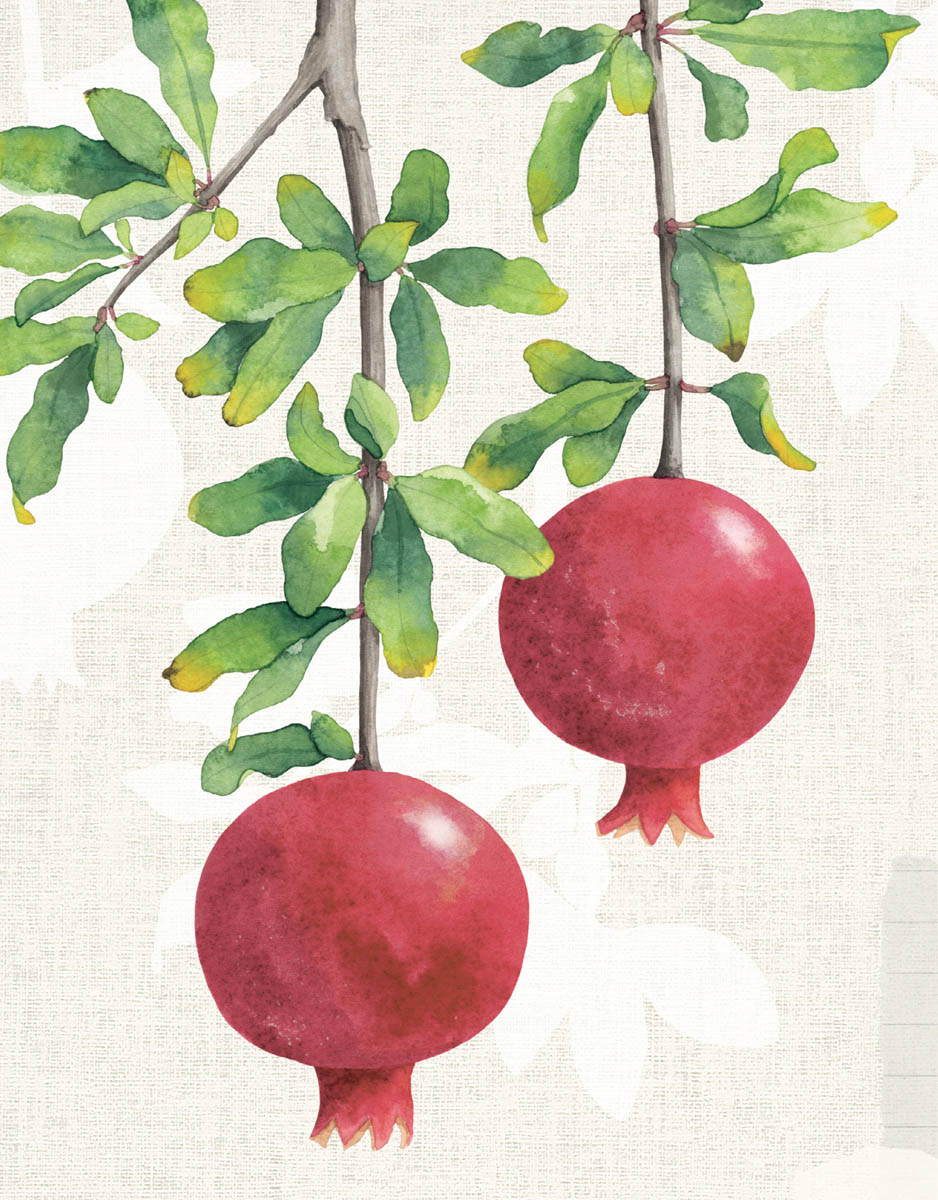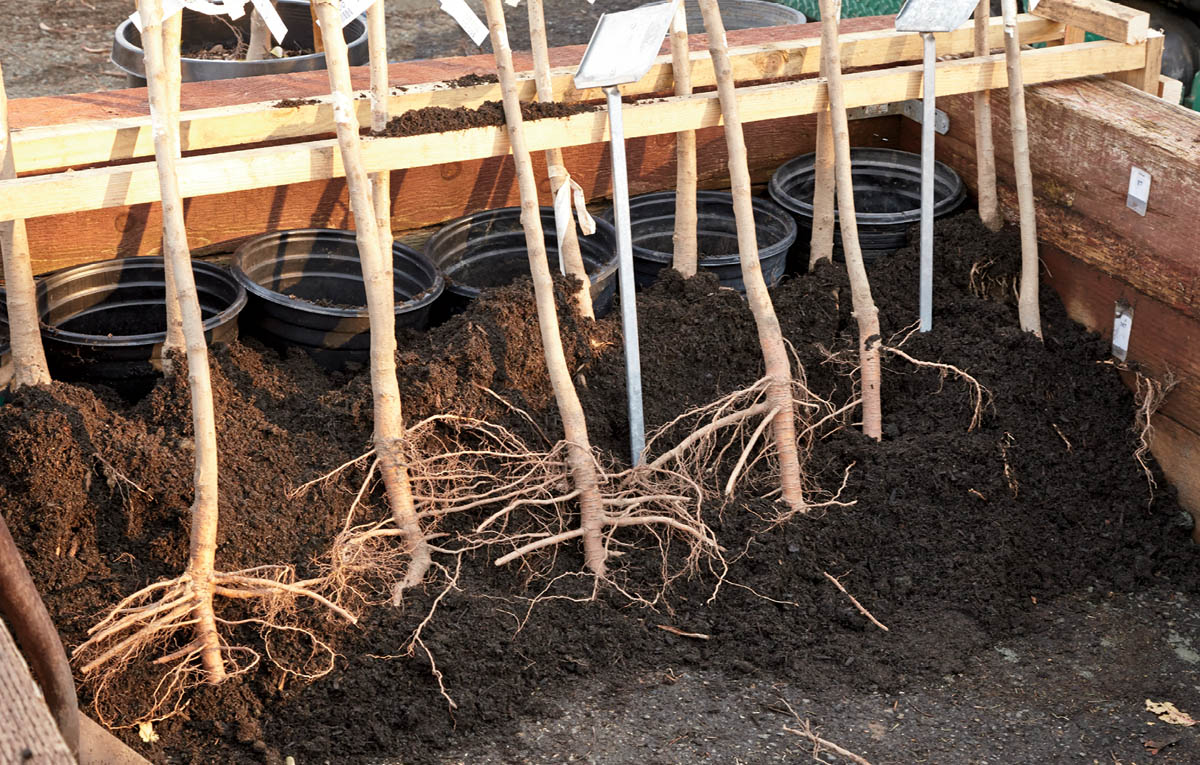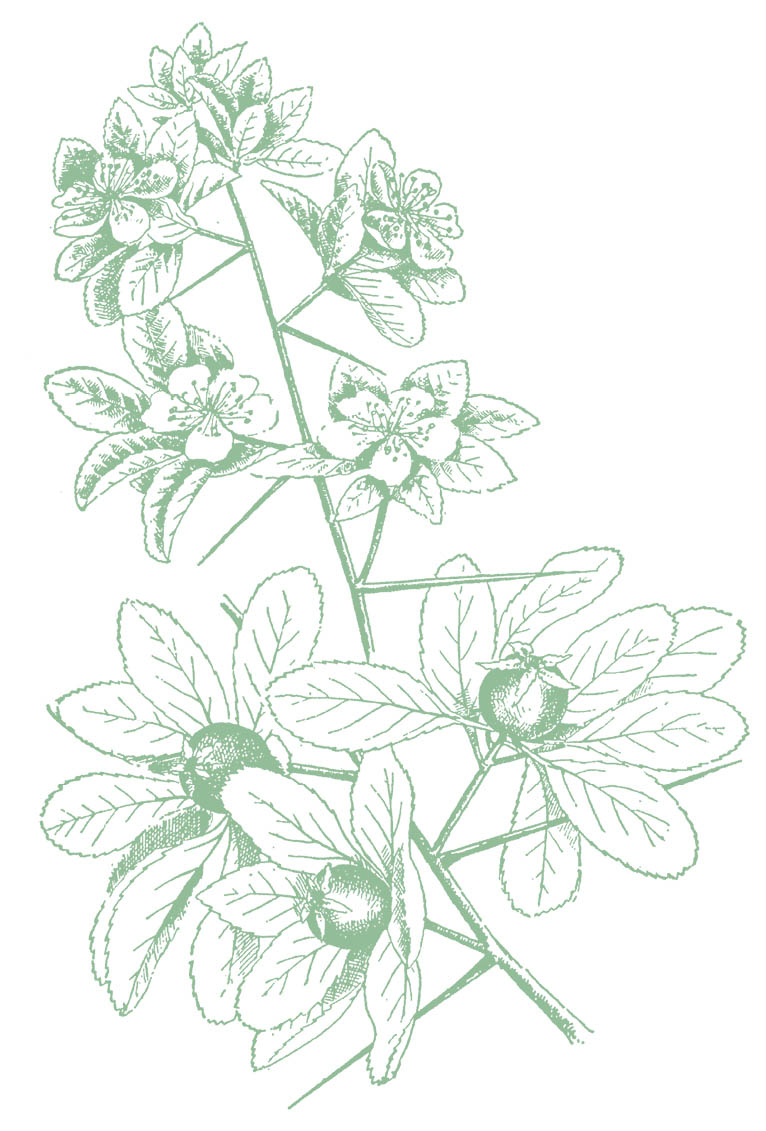

“If I ever go looking for my heart’s desire again, I won’t look any further than my own backyard.”
— from The Wizard of Oz by L. Frank Baum
For a short time in January and February in California and a little later in colder climates, deciduous fruit trees are offered for sale bareroot. In winter, saplings are dormant and the weather is usually cool and damp. Fruit trees can be dug from fields and shipped direct to you or to nurseries with their roots exposed and unprotected by soil. Most nurseries heel in bareroot plants. “Heeling in” is merely horticultural terminology for covering the roots with moist soil so they don’t dry out. The young trees are dug back into sand or moist soil and held as they are offered for sale. Some nurseries plant bareroot stock immediately into plastic or pulp containers. Ideally, though, backyard orchardists receive their naked trees in boxes by mail order or go home from the nursery with the bare roots wrapped in moist paper or burlap, or stuffed into a plastic bag.

In winter when the weather is cold and damp, dormant saplings can be dug from the soil and shipped to nurseries with their roots exposed. Once they arrive at the nursery, bareroot trees are often “heeled in” — buried in moist soil for protection.
Without question, bareroot is the best way to buy and plant fruit trees.
Bareroot season offers a first critical lesson in timing. It presents several opportunities on a limited-time-only basis: the best possible price, the widest selection of varieties, the option to plant without added amendment around the roots, and, of critical importance — and thoroughly explained in chapter 6 — the opportunity to prune a young fruit tree properly from the outset. Young trees with unconfined roots establish readily and naturally into garden soil. For reasons of economy and availability, most nurseries bring in their full supply of fruit trees for the bareroot season. In most cases, the trees you find for sale later in the year are bareroot season leftovers.

Because their roots are exposed to air, bareroot stock requires immediate attention. The principle concern with bareroot trees is dehydration, especially a problem if winters are unseasonably warm or dry. Moisture in the air helps to keep roots and bark hydrated. A tree with moist bark more easily pushes new branches from latent buds.
It’s a good idea to soak bareroot plants that arrive by mail but counterproductive to soak them more than four to six hours. Follow the instructions of the supplier. Plants held in moist soil or sand at the nursery have hydrated roots and should not require soaking, but keep the roots damp and protected for the few hours between nursery and home until they get into the ground. Soaking is of little help if the trees don’t get planted in a timely fashion and their roots dry out.
Some bareroot trees come packaged in plastic bags with sawdust, an innovation that serves the nursery (or grocery or big box store) and not necessarily the plant. You get bigger and healthier root systems if you buy your fruit tree from a nursery or a reputable mail-order company — root systems that haven’t been pruned to accommodate a small, airless bag. As the season progresses and plants begin to grow, the dicier this packaging becomes.
Plant your new bareroot trees as soon as you can. If necessary, rearrange your schedule. Plan to plant a bareroot tree on the day you bring it home from the nursery or as soon as possible after you receive it by mail. Better to leave a bareroot plant in the nursery until you can get it planted than to risk dehydration if you can’t get it in the ground right away. In nurseries and at home, heeling in — covering roots with moist soil — buys time on the hydration front.
The window for buying and planting bareroot trees is necessarily brief. As long as deciduous trees aren’t actively growing, they can be held at the nursery until they are transplanted. The object is to get the young tree planted into its new location before too many tender young roots begin to grow in spring. At Scenic Nursery, depending on the weather each winter, Jim Rogers surveyed the progress of the plants. When the saplings leafed out and their roots got too far along, he made the annual pronouncement: bareroot season is over.
When we go shopping for plants, our human nature directs us to big plants, right now, to make up for the plant we wish we’d planted five years ago. It’s difficult to pass by a plant that looks impressive in the nursery in favor of its smaller and younger sibling. Bigger is better. Except that it isn’t. This bigger-is-better philosophy doesn’t serve us when we shop in a nursery. If you want healthy plants in the long run, let them acquire their size in the ground.
When you see plants in a nursery row, don’t pick the plant bursting from its container. Choose a smaller one. Buy a one-gallon plant rather than a five-gallon plant. Buy bareroot if you can, or a five-gallon tree rather than a tree in a box. All too often, large nursery plants are compromised by their containers. You’re better off choosing a small healthy plant than starting off with a big one, a tactic that also saves you money.
In the case of fruit trees, a thicker trunk suggests age, health, robustness, strength, a better value, and fruit earlier on. However, a thinner diameter — called the caliper of the tree — is actually a better choice. Ideally, the trunk of a young fruit tree measures about as big around as your thumb when you purchase it. When I bought fruit trees for Berkeley Horticultural Nursery, I specified five-eighth-inch calipers for this reason. Young, thin trees “break” buds — or start to grow — from a hard prune more readily than older, thicker trees do. Trees only one year older won’t take to a cut like this nearly as well.
Obviously, young fruit trees won’t look that different from one another once you chop them down to knee-high — no need to agonize about which one to pick. Trees usually develop cleaner scaffolds, or main supporting limbs, if you start from scratch with no branches below the knee-high prune. While I prefer a tree without low branching, if the tree available happens to have established branches below your knee-high cut, this low branching can develop into a nice scaffold, too.

When you’re choosing a fruit tree at the nursery, select one that’s about as big around as your thumb.
Reputable nurseries and growers sell bareroot trees with established grafts and strong root systems. They won’t put them out for sale otherwise. One tree is pretty much as good as another. It won’t matter which you choose. Better nurseries also guarantee their plants.
If you have concerns about root systems or grafts — or any other apprehensions — please, have that conversation before you leave the nursery. If you feel confident after a conversation with a salesperson, buy the tree. If not, consider this good rule of thumb for live plant shoppers: never leave the nursery with a plant you have qualms about. Even if the plant is fine or will be fine once it gets into the ground, fretting over a plant tends to undermine your efforts and your likelihood of success.
Fruit trees want your sunniest real estate. My Arctic Glo nectarine grows nestled between two crepe myrtles, the only place left in the yard to put it. When the crepe myrtles are pruned, the sun comes in, and I get good crops. When the larger trees fill back in, yield declines to a disappointing few.
Full sun means unobstructed sun from about eleven o’clock in the morning until four o’clock in the afternoon. Full sun always includes noonday sun. Winter shade when trees are dormant doesn’t pose a problem. Before planting your tree, watch the spot and believe what you see. Gardeners too easily fall victim to wishful thinking. I consistently plant sun plants in a backyard area I wish were sunnier than it is. These plants just as consistently disappoint me. In short, plant fruit trees in full sun.
Fruit trees are not ideally situated in lawns. Lawn and trees are natural antagonists. Most rootstock balks at the every-other-day watering lawns on timed systems receive. (Incidentally, the lawns would prefer deeper and less frequent water, too.) If you must plant your fruit tree in a lawn, adjust to a longer and less frequent watering cycle. Or consider a persimmon, a tree that prefers regular watering and is as beautifully ornamental as it is fruitful. Check rootstock for water tolerance, especially in heavy soils. A peach, a plum, or an apricot grafted on Citation rootstock is more tolerant of irrigated gardens. Nurseries with a high percentage of customers with irrigated gardens often choose Citation as rootstock for their stone fruits. Citation rootstock requires regular water to thrive.
Lawn and trees are natural antagonists. Most rootstock balks at the every-other-day watering lawns on timed systems receive.
Apple trees tolerate lawn watering, but too much regular water gives apples and other fruit an undesirable watery quality. Cherry, apricot, and citrus trees are particularly vulnerable to heavy, soggy soils and the lawn-watering schedule. Avoid planting fruit trees at the bottom of a slope, near a downspout, or anyplace where water collects. Most of the time, fruit has better flavor and the trees are healthier if they are sited in locations where they can be watered deeply and less frequently.
Those in the grip of what National Public Radio’s Ketzel Levine calls “zonal denial” can try to take advantage of microclimates, pockets of conditions like south-facing slopes and reflecting white walls that extend the boundaries of a climate zone. If you live in a mild climate, put your fruit tree out in the open where it can use the little weather you’ve got, both in terms of heat for the sweetness of the fruit and cold for the purpose of winter dormancy. In cooler situations, tender fruit like citrus might be fine in a warm, sunny, protected courtyard.
As a rule, fruit trees are too high maintenance to make good screening plants or street trees. Fruit out of reach becomes fruit that is rotten on the ground. A fruit slick of degrading plums on the sidewalk is nothing but vile. Plant something more suitable for screening or street trees and keep small fruit trees in another part of the garden.

For years, those of us who worked in nurseries encouraged customers to amend lean soils with bagged organic matter like humus when planting trees and shrubs. We meant well but were mistaken. Soil amendment benefits bedding plants, perennials, and vegetables — in cases where roots won’t grow beyond the amended area. Research and experience indicate that most trees and shrubs are better off without it. Roots adapt to the normal soil conditions of your garden.
Soil amendments can be even be detrimental. Roots of plants and trees in unamended soil adjust to native soils. Roots that must transition from potting soil to amended soil, then to regular garden soil have a harder time. The bare roots of a tree in native soils experience no such rude awakenings — a good reason to plant bareroot when you have the opportunity.
An amended planting hole in heavy soil is like a flowerpot without drainage. Fluffy amended soil encourages roots downward into an anaerobic swamp of your own creation. Roots have better access to the air, nutrients, and water that they need if they grow near the surface of the soil. Without the interference of amendments, roots know exactly what to do. In addition, the less you disturb the beneficial microbes that live in the soil and work on behalf of your plants, the better.
At planting time, dig a wide, shallow hole deep enough in the center to comfortably accommodate the roots. Trim any broken roots and set the tree so it stands in the soil at a point about halfway between the top of the roots and the graft, the knob where the scion — the variety of your choosing — meets the rootstock.
To protect the graft from sunburn, position the outward curve of the graft so it faces south and the concave part of the grafting scar is protected from sun. Backfill the hole with native and unamended garden soil. Push the soil around the roots so it makes good contact. You don’t need to be too fussy. You want the ground around the fruit tree roughly level with the surrounding soil. Planting a bareroot tree in a broad shallow hole helps eliminate a tendency to what Ed Laivo calls “the bucket effect” — a tree that settles too deep in the ground and sinks in the center of the hole.
Tamp the soil down. Jiggle the tree to make sure it’s stable. Create a basin around the tree by building a four-inch berm to capture water and direct it toward the roots.
Water the tree once with about ten gallons of water to settle it into place. Bear in mind that the undeveloped root system isn’t yet actively growing. Once a new tree is watered in, seasonal rainfall usually provides adequate water through early spring. If the weather is unseasonably dry at this stage, five gallons of water every couple of weeks should be plenty.
You may arrive at the nursery to find fruit trees already planted into containers. These are either last season’s leftovers or newly planted bareroot stock that recently arrived. The temptation to buy an established, older tree in a nursery is almost irresistible, but do resist. Fruit trees grow quickly. A young tree is not just a better bargain, it develops into a better tree. Only a young tree takes the hard scaffold prune, and if you miss the window of opportunity to make this pruning cut when a tree is young, it’s hard to correct it later.
An older tree in the nursery is more likely to be improperly pruned, if it has been pruned at all. In addition, older trees have been sitting for an entire year with their vigorous root systems circling tight containers and subject to the vicissitudes of the weather and the watering practices of the nursery.
Some nurseries put bareroot stock immediately into containers. If it’s early enough in the season — before saplings have leafed out or even if they have leafed out as much as two to three inches — these plants can be barerooted from a container, just as you would pull a tree from a bareroot bin. Pull the tree from its container and shake off the soil. Voilà. You have just restored its bareroot status. Plant the tree according to prior bareroot directions. Protect the roots from dehydration for a few hours if you need to. Planting bareroot is so beneficial, I strongly advise barerooting containered fruit trees; that is, if it’s early in the bareroot season and the nursery just potted them up. If this advice makes you nervous, talk it over with your nursery expert. Where I live, bareroot season usually runs from January through the end of February. Check locally to see when bareroot season ends for you.
It’s risky to bareroot recently potted trees if they are in good leaf and actively growing, however. Their roots have started growing, too. Wait to plant these trees until the roots have developed enough to hold the soil around them to remove a young tree from its container, probably around June. Unlike dormant roots, actively growing roots suffer fewer setbacks and tolerate transplanting more easily with soil to protect them.
Treat a potted fruit tree as you would any shrub or tree that comes from a nursery. Dig a hole twice as wide as the container and no deeper. Gently remove the tree from its container. Set the tree into the hole and backfill with native, unamended garden soil. Again, for trees and shrubs, soil amendment mixed into the planting hole is neither necessary nor desirable. Plant your tree no deeper than it stands in the nursery container. The soil from the container should be level with the surrounding soil. No garden soil should cover the top of the root ball. Build a four- to six-inch berm of native soil to direct water to the developing roots. Water the tree the first time with ten gallons of water, or about twice as much water as the size of the nursery container. Apply four to six inches of soil amendment as surface mulch.